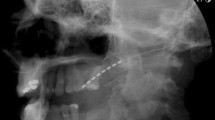Abstract
The symptoms of adductor spasmodic dysphonia are most commonly palliated by periodic botulinum toxin injections. The need for repeated injections, difficulty in obtaining injections and cost make this form of treatment intolerable for some patients. To address these concerns, we propose a new treatment approach utilizing trans-oral recurrent nerve coagulation. The goal is to weaken the force of laryngeal closure during spasms by creating fibrosis of the terminal branches of one recurrent nerve through coagulation. Under general anesthesia without paralysis, an electrical stimulator is used to identify the region within the thyroarytenoid muscle that produces the greatest contraction with minimal stimulation. The radiofrequency laryngeal probe or electrocautery device is introduced into this position, and energy is delivered. The location of the region of maximal stimulation is usually just lateral and anterior to the vocal process of the arytenoids. Between 1989 and 2000, seven patients were treated with electrocautery. To achieve remission of spasms, three patients needed three sessions, four needed two sessions and one only one session. Since 2001, three patients have achieved remission of spasms with a single treatment with radiofrequency during which 80 J was delivered. Voice results are comparable to those obtained with botulinum toxin. Initially, the voice is breathy and laryngeal examination shows complete vocal fold immobility. After 1–2 months, the voice improves and examination reveals unilateral hypomobility. Trans-oral recurrent nerve coagulation is an effective alternative to botulinum toxin injections.



Similar content being viewed by others
References
Anderson RL, Patrinely JR (1988) Surgical management of blepharospasm. Adv Neurol 49:501–520
Berke GS, Blackwell KE, Gerratt BR, Verneil A, Jackson KS, Sercarz JA (1999) Selective laryngeal adductor denervation-reinnervation. a new surgical treatment for adductor spasmodic dysphonia. Ann Otol Rhinol Laryngol 108:227–231
Biller HF, Som ML, Lawson W (1979) Laryngeal nerve crush for spastic dysphonia. Ann Otol Rhinol Laryngol 88:531–532
Blitzer A, Brin MF, Fahn S, Lange D, Lovelace RE (1986) Botulinum toxin for the treatment of spastic dysphonia. Laryngoscope 96:1300–1301
Blitzer A, Brin MF (1991) Laryngeal dystonia. a series with botulinum toxin therapy. Ann Otol Rhinol Laryngol 100:85–89
Bocchino JV, Tucker HM (1979) Recurrent laryngeal nerve pathology in spasmodic dysphonia. Laryngoscope 88:1274–1278
Dedo HH (1976) Recurrent laryngeal nerve section for spastic dysphonia. Ann Otol 85:451–459
Dedo HH, Izdebski K (1983) Problems with surgical (RLN section) treatment of spastic dysphonia. Laryngoscope 93:268–271
Dedo HH, Townsend JJ, Izdebski K (1978) Current evidence of organic etiology of spastic dysphonia. Otolaryngology 86:875–880
Frèche C, Drewski P (1983) Dysphonie spasmodique et son traitement. In: 6éme colloque ORL de Foch. Le nerf récurrent, pathologie et son traitement. Comptes-rendus 25 Janvier 1983, Laboratoires Fournier Frères, pp 59–63
Genack SH, Woo P, Colton RH, Goyette D (1993) Partial thyroarytenoid myectomy. an animal study investigating a proposed new treatment for adductor spasmodic dysphonia. Otolaryngol Head Neck Surg 108:256–264
Kosaki H, Iwamura S, Yamazaki I (1999) Histologic study of the recurrent nerve in spasmodic dysphonia. Otolaryngol Head Neck Surg 120:129–133
Ravits JM, Aronson AE, DeSanto LW, Dyck PJ (1979) No morphometric abnormality of recurrent laryngeal nerve in spastic dysphonia. Neurology 29:1376–1382
Remacle M, Plouin-Gaudon I, Lawson G (2001) Traitement de la dysphonie spasmodique par coagulation intra-cordale selon Frèche. Technique et résultats. 108éme Congrès de la Société Française d’ORL et de chirurgie cervico-faciale, Paris, 30 Sept–2 Oct
Sercarz JA, Berke GS, Ming Y, Rothschiller J, Graves MC (1992) Bilateral thyroarytenoid denervation. a new treatment for laryngeal hyperadduction disorders studied in the canine. Otolaryngol Head Neck Surg 107:657–668
Tucker HM (1989) Laryngeal framework surgery in the management of spasmodic dysphonia. Preliminary report. Ann Otol Rhinol Laryngol 98:52–54
Weed DT, Jewett BS, Rainey C, Zealear DL, Stone RE, Ossoff RH, Netterville JL (1996) Long-term follow-up of recurrent laryngeal nerve avulsion for the treatment of spastic dysphonia. Ann Otol Rhinol Laryngol 105:592–601
Author information
Authors and Affiliations
Corresponding author
Rights and permissions
About this article
Cite this article
Remacle, M., Plouin-Gaudon, I., Lawson, G. et al. Bipolar radiofrequency-induced thermotherapy (rfitt) for the treatment of spasmodic dysphonia. A report of three cases. Eur Arch Otorhinolaryngol 262, 871–874 (2005). https://doi.org/10.1007/s00405-004-0897-7
Received:
Accepted:
Published:
Issue Date:
DOI: https://doi.org/10.1007/s00405-004-0897-7




